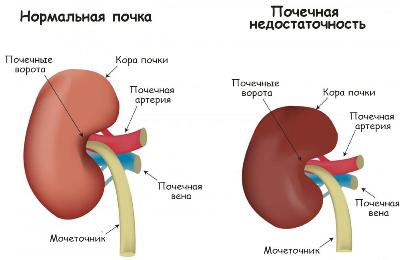Since, as noted by many scientists and clinicians, mainly mineralocorticoid antagonists are used to ensure diuresis, their prescription is included in the mandatory list of drugs for the treatment of patients with chronic heart and kidney failure.
Therefore, the subject of our article on estet-portal.com is the problem of the clinical use of diuretides, the features of their administration and the pathogenetic strategy for use in chronic renal failure.
Mechanism of action of diuretics
Mineralocorticoids, aldosterone in particular, increase the tubular return of Na cations, chloride anions and at the same time increase the tubular excretion of K cations, increase the ability of tissues to retain water, and promote its transition from the vascular bed to tissues. They are also responsible for increasing the formation of NO-synthetase, fibroblast proliferation and development of fibrosis, accumulation of Ca2 + and provoking pathological hyperexcitability of cardiomyocytes and their hypertrophy.
Follow us on Instagram!
The main representative of mineralocorticoids in the human body is aldosterone, which is mainly produced by the adrenal glands. Its synthesis is also present in the heart, vascular endothelium, brain tissue and renal glands. Basically, in pathological manifestations, conditions such as the generation of an inflammatory process, increased cytosis, and the formation of oxidative stress are associated with aldosterone. All these reactions are mediated through the influence of aldosterone on the receptor field of the cell nucleus.
One Step From the Lavatory: Treating an Overactive Bladder

Thus, the use of diuretics that block aldosterone receptors can significantly slow down its negative effect in patients with chronic heart and kidney failure, in which renin-angiotensin-(RAAS) activation is known to be one of the mechanisms of the pathogenesis of heart failure .
Clinical studies on the efficacy of diuretics
The main representative of diuretics, which is used for a long time, is spironolactone. Its use is based on the evidence base of several studies. The main one – this is a Randomized Aldacton Evaluation Study that studied the effects of spironolactone in patients with renal insufficiency. At the same time, the quality of life has significantly increased and the frequency of hospitalizations due to progression of renal failure has decreased.
Urinary incontinence in women: why it happens
However, there were also significant disadvantages of taking this diuretic: the development of gynecomastia - in 10% of patients and hyperkalemia - in 2%. The development of gynecomastia while taking a diuretic, despite the good results of treatment, had a negative effect on patients, given that the vast majority of them were older people.
New Generation Diuretics
The synthesis of the new diuretic eplerenone, a drug that can selectively block mineralocorticoid receptors, seemed to reduce the incidence of gynecomastia when taking the drug in patients with renal insufficiency. Comparison of the effect of the two drugs spironolactone and eplerenone on the effectiveness of the treatment of patients with chronic heart and kidney failure was carried out in the EMPHASIS-HF study, which showed a convincing advantage of the diuretic eplerenone compared to spironolactone.

Despite the slightly higher incidence of hyperkalemia with the new diuretic and lower affinity for mineralocorticoid receptors, which required an increase in dose, the effect on survival and readmission rates in patients with chronic renal failure was good! Cardiovascular mortality or hospitalization rates decreased by 37%
The reduction in the incidence of cardiac arrhythmias in the diuretic eplerenone group compared with spironolactone was significant.
At the same time, the increase in the level of potassium in the blood serum, although it was significantly higher compared to taking the diuretic spironolactone, did not require its withdrawal, it was enough to adjust the dose. The average daily dose of eplerenone was 39 mg, while it could gradually increase from an initial 25 mg during the first month, followed by an increase to 50 mg with good tolerance in patients with chronic renal failure. Also important was the rather low incidence of gynecomastia, which did not exceed 1.9%.
International guidelines for the treatment of overactive bladder
Eplerenone has also been shown to be highly effective in the treatment of severe heart failure in patients with acute myocardial infarction (the EPHESUS study). The use of this diuretic turned out to be very indicative and effective, especially in patients with a sharp decrease in cardiac output - EF <30%. At the same time, the use of the drug in the acute period was associated with a decrease in sudden cardiac death by 21%! This applied to patients who were at the hospital stage. That is, there was a significant decrease in 30-day mortality.
Sub-analysis of the obtained results confirmed a rather high efficacy of eplerenone in preventing complications in patients with chronic heart and kidney failure.
What symptoms indicate prostate adenoma







Add a comment